Mirfield from 1960 to 1992
Mirfield has seen many major building projects during and since the 1960s especially since its inclusion within the Kirklees Metropolitan Area. The maps below show quite graphically how the green areas of the town have all but disappeared. The maps represent 1948, 1970 and 1990. The 1948 map is included for the sake of giving a complete comparison. If you've never been concerned about the number of houses being built in Mirfield then prepare yourself for a shock.
Click any map for a larger image.
In the past Mirfield was an industrial area based mainly around textiles but later the emphasis moved towards mining and malting. Mirfield has boasted no less than 13 malt kilns at one time or another and mining was carried out at King's Head, Dark Lane and Hopton. These industries provided the wealth for a number of affluent families who lived in the manor houses and halls of the time. Many are mentioned on this site and a few remain today. Of the ones that have disappeared the sites have been developed into housing estates. The ones that spring to mind are Blake Hall and Springfield House. Many other old homes have seen new houses built around them within their grounds.
Agriculture was also a thriving industry and Mirfield sustained a number of farms, many of them owned by members of the Thwaite family. Robert Thwaite had his farm at the top of Parker Lane just above Springfield House and his fields included most of the Westfields area and fields at Crowlees and Pinfold. John Thwaite had Wellhouse Farm and a third Thwaite farmed at Kitson Hill. Most of this agricultural land has been swallowed up by housing. The few farms that remain today seem to be constrained to areas of Hopton, Crossley and Hartshead.
In 1948 the few cars in the area were owned by the industrialists, the vicar and some of our headmasters. Today there are many more families occupying all this extra housing and most of these have at least one car. Our roads on the other hand have changed very little with the exits from the town being Huddersfield Road, Leeds Road and Hopton, along with the few roads that feed into these. The road planners have carried out much work to 'improve' the main exit and entry points but these seem to have the effect of restricting traffic flow rather than speeding it up.
Fire at Holme Bank Mills
Monday March 18, 1963
Photos by Gerald Pollard.
Recollections of the fire by a young millworker at the time.
I was at work during the morning but left at lunchtime to go to Dewsbury Tech where I was finishing my H.N.C. On my way home I caught Longstaff's bus at Longcauseway, opposite the Old Fire Station. The appliances were whizzing out in the direction of Mirfield. When I got off the bus at Saville Arms it was obvious from the pall of smoke that the fire was a large one, but impossible to pinpoint its exact location. However, on reaching home I decided to get on my B.S.A Bantam and investigate. On reaching the bottom of Knowl Road I was amazed to realise it was my place of work, James Walker & Sons Ltd., Holme Bank Mills, which was on fire.
On arrival I learned the fire had broken out mid afternoon on the third floor (3rd 'oyle is it was known to us). It was believed to be a bearing on a carding machine which had overheated. Artificial or man-made fibres were being processed so the fire instantaneously flashed through the machine. Attempts were made by the workforce to put it out, but to no avail, the fire quickly took hold and devastated all three upper floors which comprised the carding and spinning plant.
To someone as young as me this was quite an exciting day but unfortunately underlined with tragedy. Everyone had managed to get out of the building safely. One lady, Mary Smithson, a condenser minder, who I believe was semi-retired, was seen in the mill yard after the outbreak but later friends and colleagues realised she was missing. It is assumed that she must have gone back in to retrieve her personal belongings, was overcome and sadly lost her life.
It was late into the night or the early hours before the fire was under control. Appliances had been despatched from as far afield as Burnley in Lancashire. The whole factory was surrounded with fire fighters with water being pumped from the Calder which runs right behind the mill.
On reaching work the following morning, just the walls remained. Twisted and tangled machinery was piled high on the first floor (1st 'oyle) which had held firm and protected the ground floor (bottom 'oyle) from all but water damage. The scouring and milling department (stock 'oyle) was on this floor and I remember being despatched to help retrieve partially processed blanket pieces which were then sent down to Butt End Mills for drying and refinishing.
At this time the carding and spinning department at Butt End had been run down and partly scrapped. What was left was quickly brought back into production. My father, a woollen yarn spinner at Providence Mills in Heckmondwike, had said they were running down operations at this plant. Dad suggested as the carding sets were for similar counts of yarn etc, I ought to mention this to the Walkers, which I did. They then negotiated use of the mill with the owners, Carpet Trades Ltd., and sent the workforce over there until a new spinning shed was built at Holme Bank.
Gerald Pollard
Waterways
During the 1960s a resurgence of interest occurred in relation to the neglected canals of the area with an increase in use by pleasure boats. The Calder and Hebble Navigation had opened in October 1776 and was very important in the transportation of coal and other produce of the area. In later years these industries had declined and the canal was mostly unused and falling into decay.
It is true to say that in the late sixties there was a real possibility that the section of canal above Brighouse might be closed. If this had happened then it is certain that the downstream sections, including that which passes through Mirfield, would also have closed. The Calder Navigation Society was formed in 1969 to combat the proposed closure. It also took on the task of promoting the waterway which it did by buying the launch, Doreen, and running passenger trips. This raised interest in the canal for its use by pleasure craft.
With the shift of interest moving to the leisure industry much work was carried out to clean up the waterways. This interest was country wide and meant that many routes were re-opened to other parts of the country and this gave pleasure-boating an additional boost. The towpaths have also benefitted from all this interest and a great deal of work has been done to improve them so that today they provide many miles of pleasant walks beside the tranquil water. There has been talk of the footbridge that crossed the river at Newgate being rebuilt but, so far, this has come to nothing.
Reduction of the Railways
Up until the late sixties Mirfield was the site of a busy locomotive depot and sorting sidings. Mirfield had an engine shed at the Huddersfield side of the station which had a turntable so the steam engines could be turned round for coupling to the trains that were assembled in the large marshalling yard on the Leeds side of the sation. These trains were assembled from trucks brought here from many other areas.
The shed closed to steam engines on 2nd January 1967 when the newly opened diesel depot at Healey Mills started operations. The engine shed survived for many years as the home to Patterson's road tankers but was finally demolished in 2007. All around Mirfield station were numerous railway lines with points crisscrossing between them. Seeing the simple rails we have today, it is difficult to visualise the hive of activity it used to be.
Battyeford Station and the Leeds New Line were early casualties of the desire by the Government of the day to reduce the running costs of the railways. British Rail was running at a loss of £140m a year at the time and Dr Richard Beeching, the chairman of the British Transport Commission, was charged with the task of making the railways profitable. Rightly or wrongly Dr. Beeching has carried the burden of blame for the decimation of our railways that occurred following his report but it was the government ministers that were swift to implement the cuts that were outlined but slow to implement the improvements recommended in other parts of the report.
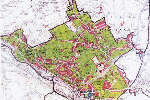
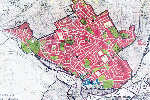
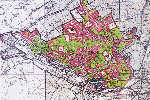 click for larger image
click for larger image




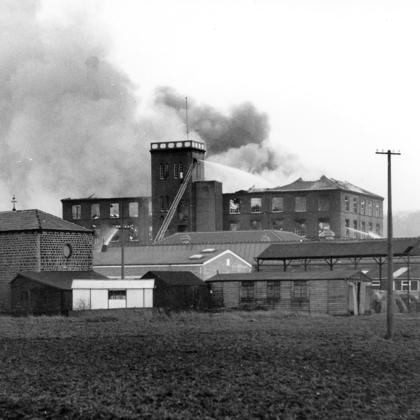
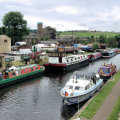
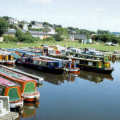
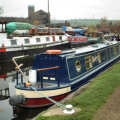
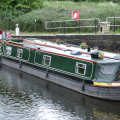
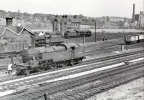
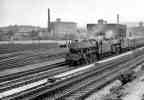
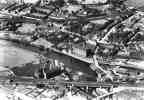 click for larger photo
click for larger photo